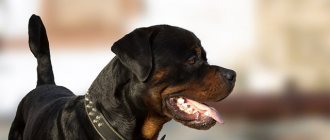3.7 / 5 ( 3 voices)
Vaccinations guarantee the health of not only dogs, but also humans. Some viral diseases, in particular rabies and leptospirosis, are dangerous not only for pets, but also for their owners. Vaccination is an effective prevention of many serious problems.
Why should you vaccinate your dog?
Vaccinations are required for everyone, without exception, for pets. To protect the pet, owner and others from serious viral diseases, many of which can cause serious damage to health or even lead to death.
According to the law on veterinary medicine of the Russian Federation, all domestic animals must be immunized against rabies. Otherwise, regulatory authorities have the right to issue a protocol on an administrative violation.
An animal that has not been vaccinated against a standard set of viruses is not allowed to participate in exhibitions or released abroad. Any canine and veterinary organization has the right to refuse admission if there are no vaccination marks in the veterinary passport.
Vaccination rules
Each veterinary institution has a standard set of rules for immunizing animals.
Standard principles for vaccination:
- Preliminary deworming of the dog 10–14 days before vaccination;
- No signs of secondary diseases;
- Normal body temperature;
- Revaccinations should not be given at intervals of less than 21 days;
- Immunization is prohibited for pregnant and lactating females;
- During the change of teeth, the puppy’s immune system is very vulnerable; vaccinations are not recommended during this period of time;
- Bitches in heat can be vaccinated only if mating is not planned; when planning offspring, immunization is carried out in advance, no earlier than 2 weeks before mating.
Large dogs and pets included in the list of potentially dangerous breeds must have a muzzle. In his absence, the doctor has the right to refuse admission.
Features of care before and after vaccinations
- Before each vaccination, it is necessary to do helminth prophylaxis, approximately two weeks before the scheduled appointment . If there are signs of helminthic infestation, as well as for small puppies, before the first immunization, anthelmintic is given twice with an interval of two weeks.
- Approximately 3–4 days before visiting the veterinarian, it is necessary to especially carefully monitor the pet’s health. Measure body temperature daily. Any vaccination is given only to a completely healthy dog. Otherwise, the body's reaction to the latent virus introduced with serum may be unpredictable. A weakened animal may not develop immunity from the drug, but rather will get sick from the vaccine.
- Puppies from birth, before revaccination and another 2 weeks after it must observe strict quarantine. It is prohibited to walk in common areas or communicate with other animals, with the exception of littermates and the mother. It is not recommended to communicate with strangers without observing security measures.
The American Staffordshire Terrier is in heat
The first heat of an American Staffordshire Terrier female occurs at 6 – 12 months.
It takes place twice a year (there are exceptions) and lasts from 7 to 28 days (on average two weeks). At this time, the Amstaff female can become pregnant. The cycle is experienced in 4 stages:
| Stage | Duration | Discharge | Signs |
| Proestrus | 4 – 9 days | bloody | Males during this period are interested in females, but without reciprocity. |
| Estrus | 4 – 13 days | yellowish color | The bitch becomes favorable to the representatives of the “stronger sex”, conception is possible. If you touch the lady's tail, she moves it to the side and lifts her pelvis. |
| Metestrus | 60 – 150 days | — | The bitch stops letting males in. At the beginning of this period, false pregnancy is possible. |
| Anestrus | from 100 to 160 days | — | Ovarian activity decreases. There are no significant external signs. |
What vaccinations does a puppy need?
The standard vaccination complex provides protection against diseases such as:
- Carré's disease (canine plague) is a contagious viral disease that affects the nervous system. It is difficult for small puppies to tolerate and leads to death in 80% of cases;
- Rabies is dangerous for all warm-blooded animals, including humans. Cannot be treated. The infected animal must be euthanized, or death occurs on its own within 5 days;
- Parvovirus enteritis is a highly contagious viral disease, especially dangerous for young dogs under 12 months, the fragile organism dies in 95% of cases;
- Leptospirosis - jaundice, instantly affects the liver. Dangerous to humans, it spreads very quickly. In most cases it leads to the death of the animal;
- Infectious hepatitis - can lead to blindness and liver dystrophy; with fulminant hepatitis (more common in puppies), death occurs within 2 days; the virus is transmitted by contact.
Additionally, veterinary clinics offer vaccinations against:
- Piroplasmosis;
- Depriving;
- Parainfluenza;
- Adenovirus.
Also, depending on the region of residence and the number of epidemics in the area, the doctor may recommend additional immunization.
You should not ignore the veterinarian’s recommendations; he has information about the increasing incidence of diseases and will help prevent possible infection.
Vaccination table for puppies in their first year of life
| Age | Diseases | Notes |
| 8 – 12 weeks |
| First vaccination |
| 11 – 15 weeks |
| Revaccination |
| 11 – 15 weeks |
| The first immunization, if the puppy is kept in a greenhouse, can be postponed until the change of teeth |
| 9– 12 months |
| Last puppy vaccination, next in a year |
| 9 – 12 months |
| Last puppy vaccination, next one in a year |
All data entered in the table is approximate and may change based on living conditions, viruses attacking in a particular region and the puppy’s health condition.
Primary vaccination
Primary vaccination is recommended to be carried out at the dog owner's home. To avoid contact of the puppy with sick animals in the clinic. Immunization is carried out only for completely healthy pets, and upon contact with potential carriers of infections in a veterinary institution, this condition may be interrupted.
Revaccination
It is proposed to do a double vaccination, also with a veterinarian visiting your home . Until the puppy’s immunity is fully formed, contact with animals in the hospital should be avoided, because it is unknown what disease carriers come there. Moreover, having a doctor come to your place of residence will relieve the puppy of additional stress.
Giving birth to an American Staffordshire Terrier at home
It is necessary to prepare everything you need in advance. The “birthing room” should be warm, ventilated and calm, as well as comfortable for people - you will spend quite a lot of time there. A week before the expected birth, move the Amstaff bitch to the “delivery room”, she should get used to this place.
Prepare a box for newborns (special beds are available for sale). You will also need: infrared heating lamp, disposable diapers, heating pad or plastic bottle with warm water, cotton wool, cotton rags, towels (8 pieces), hand wash, thermometer, milk replacer, bottle and pacifiers, muzzle, collar, leash, glucose solution.
Keep your veterinarian's phone number visible.
A day before the event, the dog refuses to eat, and the body temperature drops. The bitch becomes restless, tears up the bedding and makes a nest.
IMPORTANT: The dog must be closely monitored so that it does not climb into a hard-to-reach place.
When labor begins, call your veterinarian and let him be on call just in case. Place a collar on your American Staffordshire Terrier bitch. Next, your task is to sit quietly and not fuss. You can do yoga or meditate.
Stages of labor
| Stage | Duration | Characteristic | Behavior |
| First | about 12 -24 hours | The cervix relaxes and dilates, mucus comes out, contractions without pushing, the temperature is lowered | The dog is worried, often changes its position, looks back at its stomach, breathing is rapid, vomiting is acceptable |
| Second | normal up to 24 hours | The amniotic fluid recedes, the temperature returns to normal, the abdominal walls are tense, contractions are combined with pushing, puppies emerge from the birth canal | The dog stops worrying, breathes quickly, lies down in one place, strains, after the fetus comes out, breaks the placenta and licks the puppy |
| Third | The afterbirth comes out from either the placenta or the baby part of the placenta. Usually, after the birth of a puppy, the placenta comes out within 10-15 minutes. Sometimes several come out, after 2-3 puppies. | The bitch tries to eat all the afterbirth, do not allow her to do this. One or two is the maximum, otherwise there may be intoxication (diarrhea, vomiting). | |
The puppy is born in a “package” - a transparent film called the afterbirth. Usually the Amstaff bitch tears it herself and eats it. Don't be alarmed - this is normal, she won't eat the puppy.
IMPORTANT: Do not allow the bitch to eat the afterbirth if it is greenish-black in color with a putrid odor.
Keep track of the number of afterbirths, there should be as many as there were puppies. Sometimes the afterbirth may remain inside and only come out at the end of labor.
IMPORTANT: If at least one placenta remains inside, this is fraught with inflammation (metritis) for the bitch. If you are not sure that all the placenta has come out, be sure to take your dog for an ultrasound.
A puppy can be born while the bitch is standing. It falls to the ground, but it's usually harmless. Intervention is only justified if the mother is in shock, ignores the cubs, or attacks them. In this case, call an experienced breeder - he will tell you what to do.
Something went wrong…
If the mother tries to attack the puppies, muzzle her and move each pup out of earshot. Remove the film, wipe the puppy with a towel, and remove mucus from the mouth and nostrils with a syringe. If the puppy is not breathing, try rubbing him with a towel. Sometimes artificial respiration is necessary - gently breathe air into the puppy's mouth and nose. The chest should rise at the same time. Repeat the breath every 2-3 seconds until the puppy begins to breathe on its own. Place the puppies in a cardboard box with a heating pad. Make sure the kids don't get burned.
IMPORTANT: Remember that the dog is in a state of shock, talk to it gently, calm it down.
After the birth is over, when the Amstaff female has rested and drunk milk with glucose, try introducing her to the puppies again. Lay the mother on her side, hold her head, stroke her. A second person can hold the puppy to the nipple. If the bitch has accepted the puppy, you can carefully place the rest. But keep holding it.
Even if everything is fine, you should not relax. After feeding, clean the puppies and wash their butts. If your dog is comfortable licking the puppies, you can choose to risk leaving them in her care or take the box away and return it for the next feeding.
Sometimes, in the first hours after giving birth, due to shock, the Amstaff bitch ignores the puppies: she refuses to feed, wash or stay with them. Here you will have to force the bitch to feed the puppies, but you will have to wash the babies yourself. Massage (clockwise) the perineal area with a cotton swab soaked in warm water to stimulate the release of feces and urine.
Sometimes an Amstaff female tries to kill her offspring. But it’s still better to force her to feed the puppies. Put a muzzle on her and secure her in a lying position. One person can hold it and the other can apply the puppies to the nipples. Artificial feeding is not a substitute for breast milk, so use it only as a last resort.
Important: Puppies need a full feeding every 2 hours.
As a rule, sooner or later the Amstaff female still accepts puppies. Cases when hatred turns out to be persistent are extremely rare.
Warning: Whatever happens, even if the bitch eats all the babies, don't blame her. The birth of the puppies was your idea, and it was you who forced the bitch to give birth. She doesn’t understand what she’s doing; hormonal imbalances and shock force her to behave in a way completely unusual for her.
Possible complications
Caesarean section is the surgical removal of puppies when they cannot be born naturally. If you leave puppies within reach of a recovering bitch, she may kill them.
Eclampsia is milk fever associated with calcium deficiency. Symptoms: anxiety, semi-consciousness, tossing, and sometimes convulsions. A calcium injection can work wonders in this case.
Mastitis is a bacterial infection of the mammary glands. Symptoms: fever, lack of appetite. The affected nipple is hot, sore and swollen. Veterinarian consultation and antibiotics are required.
Metritis is inflammation of the uterus after childbirth. Causes: retained placenta, injury or dead puppy. Symptoms: dark discharge, loss of appetite, high fever. Urgent treatment with antibiotics is required, possibly a smear test.
Vaccination of an adult dog
Vaccinations for adult dogs are no different from puppy ones . The veterinarian administers the same serum, under the same conditions as for the puppy. Only the dosage of the drug and the principle of quarantine differ.
For adults, after deworming and vaccination, quarantine is not necessary. For a mature organism, revaccination is not necessary; an injection is given against all viral viruses (including rabies) once a year.
Complete vaccination schedule for dogs
Pet vaccination schedule:
- First vaccination – 8 – 12 weeks;
- Revaccination – 11 – 15 weeks;
- First rabies vaccine – 11 – 15 weeks;
- The last puppy vaccination (combined with rabies) - after a complete change of teeth 9 - 12 months;
- First adult immunization – 21 – 24 months.
The vaccination at 21–24 months is given in combination with rabies serum and is repeated annually until the end of the dog’s life.
False pregnancy in an American Staffordshire Terrier
False pregnancy is a common occurrence in dogs of all breeds, including Amstaffs. This is the name for the psycho-physiological state of a bitch that has not been fertilized, but still shows signs of pregnancy. In this case, the dog diligently arranges a “nest” and may even experience something similar to contractions. As a rule, false pregnancy is observed in dogs with irregular matings and is associated with hormonal development disorders.
IMPORTANT: If a dog is sterilized, a false pregnancy will not occur!
If the Amstaff bitch begins to show signs of false pregnancy, it is necessary to remove the toys. Self-licking of nipples increases the symptoms of false pregnancy. This can be prevented by putting a collar and blanket on the dog. Limit your protein intake.
If the bitch is showing aggression, extreme agitation, or developing physical problems (such as mastitis), medication will be needed. Contact your veterinarian.
IMPORTANT: False pregnancy can be a symptom of a disease (hypothyroidism or liver dysfunction).
If there are frequent strong manifestations of false pregnancy in the American Staffordshire Terrier, you should contact the clinic for examination. Most likely, you will be asked to donate blood for biochemistry and hormones.
Cost of the procedure
Vaccination prices vary depending on:
- Manufacturer of the drug.
- Spectrum of diseases covered.
- The level of service of the clinic.
- Where is the serum applied (going to the client’s home is more expensive than on site).
- Region of residence.
- Degree of competition among clinics.
- Veterinarian qualifications.
The average price for comprehensive vaccination ranges from 500 to 1000 rubles at a veterinary institution. With a home visit, depending on the client’s location, from 1000 to 2000 rubles .
Types of vaccines
The most popular vaccines used in Russia are divided into 4 types:
- Inactivated serums.
- Attenuated vaccines.
- Anatoxins.
- Chemicals.
The differences between the above vaccinations are based on the composition of virus strains and the principle of immunity formation in the body.
Also, modern sera are divided into single vaccines and complex ones; they differ in the possibility of developing immunity from one disease or several, respectively.
Complex serums are very popular; they are more convenient to use (there is no need to make several injections) and cheaper.
The most common drugs used at the moment:
- Nobivak. There are several types, both mono and complex. Manufactured in the Netherlands. This drug is safe even for puppy dogs, but is used only when absolutely necessary, after consultation with a veterinarian. The overall market rating is 4 out of 5, the price of the drug varies depending on the complex of diseases from 100 to 800 rubles .
- Multikan. The complex preparation of domestic production is divided into 3 types depending on the number of diseases included. It is highly efficient and has good consumer reviews. The price of the drug is in the range of 200 – 600 rubles .
- Vanguard. Also a complex vaccine made in the USA. Very effective, but protection against rabies is not included in the composition; it must be installed separately. The average cost of the drug is 300 - 500 rubles .
- Biocan. It has a wide range of protection, but reviews from owners are not all good; enteritis occurs in vaccinated dogs. Manufacturer: Czech Republic, prices in veterinary pharmacies range from 300 to 600 rubles.
Despite the different types of drugs, they are administered according to the same scheme. The serum is injected subcutaneously into the withers or intramuscularly.
Complications after vaccinations
Over the next two days after immunization, the dog’s body develops immunity to viruses.
- At this moment, the pet may be a little depressed and refuse food. There is no need to be afraid of this, everything should go away within the next 48 to 72 hours . Otherwise, you will have to contact the clinic again.
- Allergic reactions to vaccinations are possible in theory, but in practice such cases are extremely rare. Despite this, many modern veterinary institutions value their reputation and give an injection of an antihistamine before administering antiviral serum.
If your pet begins to experience allergic reactions after the vaccine (swelling, itching, redness and discharge from the mucous membranes), you need to seek help from the doctor who administered the injection. And at the next immunization, use a different serum.
Thanks to an increase in the level of canine literacy of the population and a breakthrough in veterinary medicine. Over the past two decades, it has been possible to reduce the mortality rate of animals under 3 months of age by almost 3 times. It was possible to reduce rabies epidemics in populated areas by 5 times. This is how many lives are saved thanks to a simple injection in the withers.
Pregnancy in an American Staffordshire Terrier female
You can knit a dog when it reaches 2 – 2.5 years. If the dog is older than 4 - 5 years, pregnancy and childbirth may be associated with complications.
IMPORTANT! “Pregnancy is for health” is one of the most dangerous myths of many owners!
Pregnancy is not a healing process. This is a lot of stress and strain on the immune system and internal organs. Therefore, only a perfectly healthy dog should give birth.
As a rule, the pregnancy of an Amstaff bitch lasts 63 days. The maximum difference is from 53 to 71 days, in which case the puppies are born viable.
1. At an early stage (the first 3 weeks after mating), it is impossible to determine whether the American Staffordshire Terrier bitch is pregnant.
2. At the 4th week, using ultrasound, you can estimate the approximate number of puppies.
3. At the 5th week, the sides become more convex (sometimes the sign is absent until the 7th week), the skin of the nipples becomes lighter.
4. At the 6th week, puppies can be palpated. After this, the size of the fruit increases, the nipples become softer and larger.
IMPORTANT: It is better if the palpation is carried out by a veterinarian; you can damage the fruit yourself.
During pregnancy, the dog should move, but not become overtired. The expectant mother should not be disturbed unless absolutely necessary, take long trips by car or public transport, or be kept in a noisy, cramped room. If during pregnancy your dog's condition suddenly changes, he begins to refuse to eat, his temperature rises, or there is discharge from the genitals, you should consult a veterinarian.
The second half of pregnancy may be characterized by minor mucous discharge. The discharge becomes abundant, yellowish or greenish - this means that labor is approaching. 1–2 days before giving birth, the dog begins to worry, whine, lick the genitals, and scratch the walls or floor. Pulse, breathing, and urination increase. The dog refuses food and drinks constantly.











